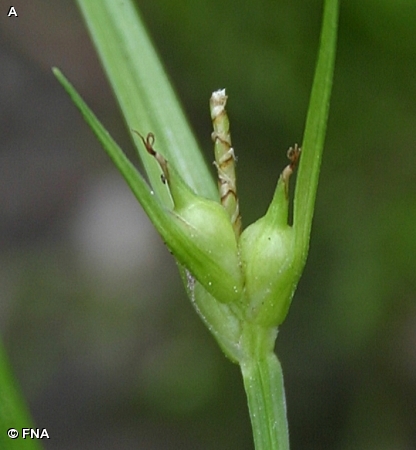
Bunched perennial with erect or nodding stems 2-12 inches tall bearing distinctive spikes at their tips. The small central male spike has brown and green scales with white edges and is less than 1/2 inch tall. The female spike with its 1-4 green perigynia lies at its base (A). Perigynia taper abruptly to a long pointed beak. Arising below the perigynia are two distinctive, narrow 1/2-2 inch leaf-like bracts which rise above the spikes (E).
Moist bottomland and upland woods. This sedge is rare at Fontenelle Forest, but there is an easily accessible and quite large colony on Hawthorn Trail about 100 yards below the Buffett Forest Learning Center. It is quite common at Neale Woods on Missouri River Ecology Trail and in the uplands along upper Neale and Settlers Trails. Flowering occurs in late April and early May. perigynia persist into June.
James’ Sedge is easily separated from all but Rocky Mountain Sedge (Carex saximontana) by its distinctive, prominent, leaf-like bracts which rise well above the male and female spikes. Rocky Mountain Sedge, which is rare at both Fontenelle Forest and Neale Woods, is found in drier upland sites and has broader, more prominent bracts that usually conceal the underlying male and female spikes. Its bluish-green leaf color is also quite different from the deep green of James’ Sedge.
This species is named for Edwin James, botanist on the 1819-20 Long Expedition. The party wintered just north of Neale Woods, but we do not know exactly where James actually collected the original type specimen. Another common name for this species is Grass Sedge.
The content of NatureSearch is provided by dedicated volunteer Naturalists of Fontenelle Forest who strive to provide the most accurate information available. Contributors of the images retain their copyrights. The point of contact for this page is: Neal Ratzlaff.




